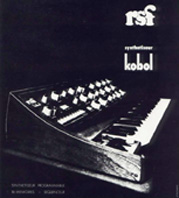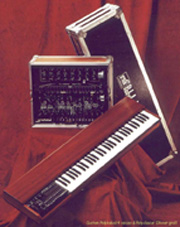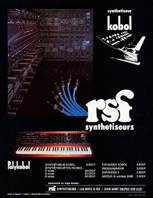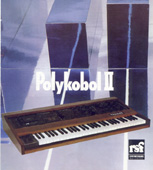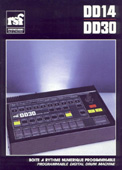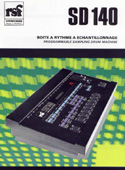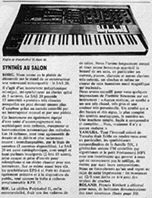Ruben and Serge
Fernandez come from
the French city of Tarbes located in the south-west of France nearby
the Pyrénées mountains. In 1972, while they were building
small sound devices they became acquainted with a Moog synthesizer and
decided to build their own sound synthesizer. In september 1975, they
moved to Toulouse to complete their academic studies : Ruben graduated
in Computer Science (where he learned the Cobol programming language)
and Serge graduated in Electric Engineering. In a first stage
they produced custom modules for their musician pals in Toulouse.
The Série 11 modulars appeared in 1976.
|
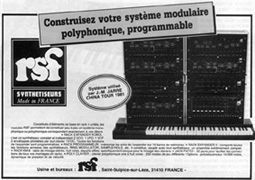
|
VERTO, the
french guitar player was one among the first users and contributed to
the evolution of the Série 11 and also to the design of the
keyboard version of the Kobol.
In
1976 they met Klaus Schulze who introduced the EMS synthi to them, and
starting from that moment the design and production of their new
systems were boosted. They created their company (a SARL) name RSF (the
initials of Ruben Serge Fernandez) and production started in a small
house located rue
Claire Cazelles in Toulouse.
About twenty modular systems (some of them housed in Samsonite
suitcases) were sold accounting for a total of more than 300 modules.
Next a series of master keyboards was also released among which a
special portable model for Benoît Widemann (keyboardist of the
famous French band Magma) that was customized to control Benoît's
Minimoog. Benoît was also very committed in the development of
all the synths of RSF.
|
|
The
keyboard version of
the Kobol appeared in 1978 and part of the external design is due to
Klaus Blasquiz (lead singer of Magma). The woodwork of the very first
models was made by Michel Chavania (also known for LAG guitars). Grey
was the colour of the control knobs. The name Kobol comes from a small
character of the German mythology. RSF aimed at the "top notch" market
and the Kobol was clearly inspired by the Minimoog. As such, it was a
real success and it's fantastic sound seduced and convinced many
professional musicians among which Jean-Michel Jarre, Kate Bush, Vince
Clarke, Bernard Szajner, Vangelis and Peter Gabriel who actually came
to try it after a concert in Toulouse back in 1980. The Kobol featured
a very rare function : it was possible to sweep continuously from one
waveshape to another, what we'd call "wave-morphing" nowadays.
Among the other features were : memories, sequencer, stable VCOs and a
very musical filter. All these contributed to success, although it was
difficult to get a part of the synthesizer market that was already
dominated by huge American and Japanese companies. In France, the
market was small and because of a lack of confidence and promotional
means the sales remained rather low. However, with the next modular
series sales started to raise.
|
|
The
rack version of the
Kobol was released in 1979. As a matter of fact it came in four
different racks : the Kobol Expander that contained the synthesis voice
only, the Programmer rack that contained the memory circuits and the
Expander 2 rack where could be found some auxiliary modules that were
not available in the original Kobol and eventually the KM-8 an eight
voices mixer. The connections between modules were normalized but could
superseded by external patches turning it into a genuine modular
system. This made it very appealing for schools of music and electronic
music composers. Meanwhile, RSF built a one of a kind mixing desk
(TPU12) for the recording studio Condorcet in Toulouse.
Fame occurred when Jean-Michel Jarre brought his huge RSF modular
system on tour in China. By this time RSF developed a polyphonic
keyboard, the Polyclavier. The Polyclavier was associated to four
voices polyphonic systems based on Kobom racks in order to satisfy the
increasing requests from musicians for a polyphonic Kobol. However,
only
five or six of these polykobol ancestors were built. With no auto-tune
function and without polyphonic modulators these systems were rather
limited.
|
|
| In
1981, the Fernandez
brothers splitted and they created separate companies of their own.
Serge created RSF Sono in Toulouse, a small business of sono and
lighting gear; where he also designed light show control desks. Ruben
created RSF SA. Synthétiseurs in Saint Sulpice sur Leze and
employed ten persons. They were meant to produce the Polykobol 2, but
this model never showed up because of the difficulties of adaptation of
the electronic boards of the Kobol. As a matter of fact, only one 4
voices prototype that was not even working and a wood cabinet. |
|
Following the advices of
many musicians among whom Benoît Widemann, the Polykobol 2
project was reactivated and eventually became more ambitious including
new features such as a digital polysequencer, a dynamic keyboard, a K7
tape interface, more modulations and an arpeggiator. Unfortunately, RSF
SA. did not have the finances to fully support the development costs.
Furthermore, because of the design complexity (more than 500 parts
including three 6809 CPUs), the electronics of this synthesizer was
very unstable. Its release was postponed many times and this also
delayed the development of other products. Only the Blackbox was
released during this period, this device was meant to produce polyphony
with a monphonic synth. It was hugely inspired by the EML Polybox and
appeared to be a sale winner because of its budget price.
|
|
By
the end of 1982, RSF SA is
bankrupted and the ARIA society whose manager was Mr Baumesnil bought
it with all the stock, half of the staff and the new prototype of the
rhythm machine DD10 for a total amount of US$20,000. Ruben Fernandez
became technical director and kept designing new products. The aim of
ARIA was to diversify its assets and thus wished RSF to be a profitable
investment quickly. The first Polykobol 2 were eventually shipped to
their patient customers by the summer 1983, some of the latter did
place their order and paid for it more than one year before. Meanwhile,
the Polysequencer and dynamic keyboard did not work and the Polykobol 2
totally lacked of stability. Even though it provided marvellous sonic
capabilities it was a complete commercial failure since its price of
US$12,000 was for the happy few and at the same time Yamaha released
the DX7 for US$3,000. The digital revolution was beginning... farewell
analogue monsters !
|
|

